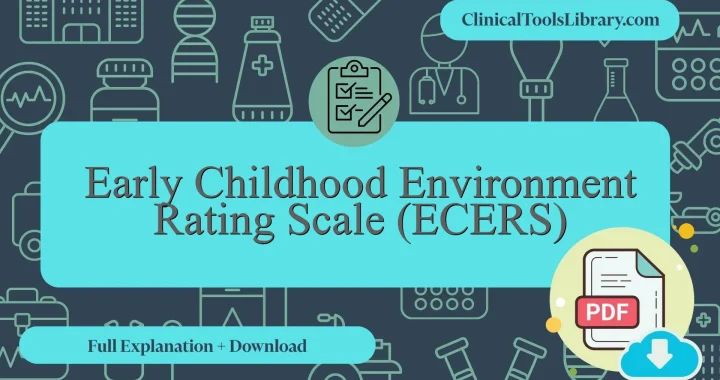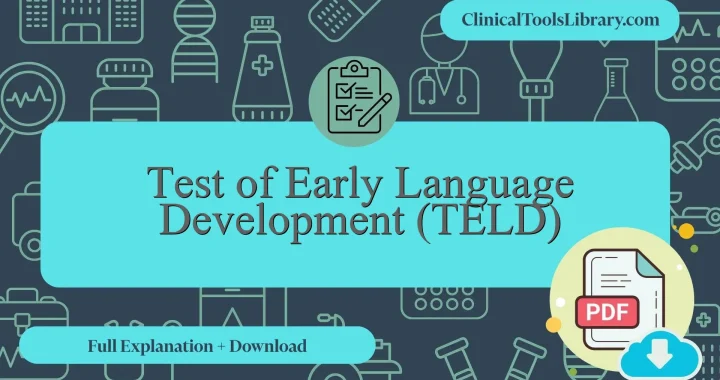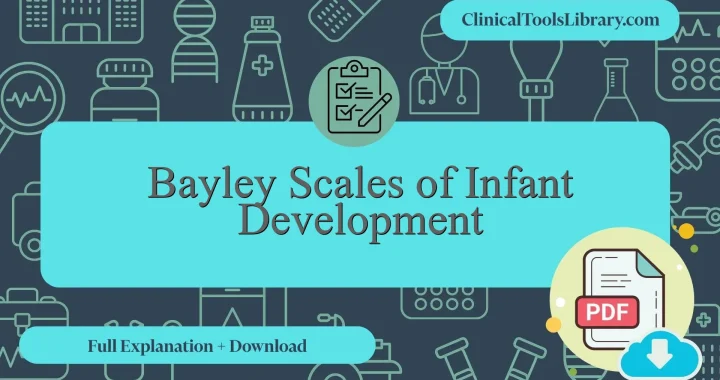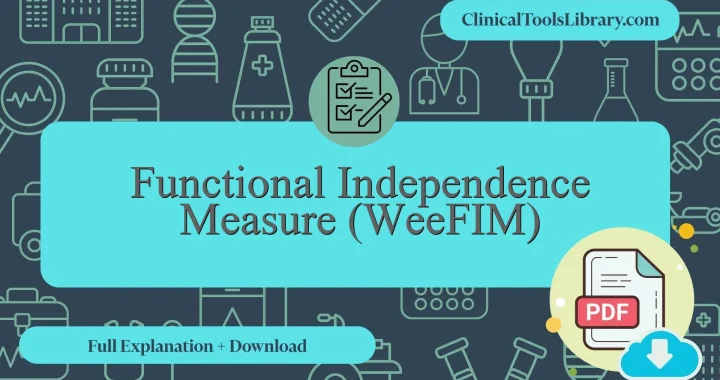In this article, we explain everything you need to know about the Early Childhood Environment Rating Scale (ECERS). We will cover the aspects it evaluates, the target population, a detailed step-by-step explanation, and how to interpret its results. Additionally, we will dive into the scientific evidence supporting this tool (diagnostic sensitivity and specificity) in clinical assessment. You will also find official and unofficial sources available for download in PDF format.
What does the Early Childhood Environment Rating Scale (ECERS) assess?
The Early Childhood Environment Rating Scale (ECERS) is a comprehensive assessment tool designed to evaluate the quality of care and educational environments in early childhood settings. It systematically measures various domains including space and furnishings, personal care routines, language and reasoning, and interaction, which are critical for promoting optimal child development. The main purpose of the ECERS is to provide objective data that supports the enhancement of program quality by identifying strengths and areas requiring improvement in environments serving young children. Variants such as the Infant/Toddler Environment Rating Scale and the School-age Care Environment Rating Scale extend this evaluative framework across different age groups, ensuring age-appropriate standards. Practitioners and researchers often refer to the ECERS-3 version, which incorporates updated standards reflecting current best practices in early childhood education. Access to resources like the Early childhood environment rating scale ecers pdf free download facilitates broad utilization and consistent application in diverse settings.
For which type of patients or populations is the Early Childhood Environment Rating Scale (ECERS) intended?
The Early Childhood Environment Rating Scale (ECERS) is primarily indicated for assessing quality in preschool-aged children’s educational settings, typically aged 3 to 5 years. It is most useful in clinical and developmental contexts where evaluation of learning environments can inform interventions aiming to enhance cognitive, social, and emotional outcomes. This scale aids healthcare professionals, early childhood educators, and childcare program administrators in identifying environmental strengths and areas needing improvement, particularly for populations requiring support due to developmental delays or neurodevelopmental disorders. Utilization of ECERS facilitates evidence-based enhancements in classroom settings, promoting optimal early childhood development and facilitating better health and educational trajectories.
Step-by-Step Explanation of the Early Childhood Environment Rating Scale (ECERS)
The Early Childhood Environment Rating Scale (ECERS) consists of 43 items designed to assess the quality of early childhood environments systematically. The instrument covers several domains, including space and furnishings, personal care routines, language and reasoning, activities, interaction, program structure, and parents and staff. Each item is evaluated through observational checklists and structured questions, with responses rated on a 7-point scale ranging from 1 (inadequate) to 7 (excellent). The evaluator scores items by comparing observed practices against defined criteria to determine compliance and quality. The scale employs both quantitative ratings and qualitative notes to capture nuanced aspects of the environment, facilitating comprehensive assessment necessary for improving care and educational outcomes in early childhood settings.
Downloadable PDF Resources for Early Childhood Environment Rating Scale (ECERS) & Infant/Toddler
Downloadable resources are provided below in PDF format for both the original and English versions of the Early Childhood Environment Rating Scale (ECERS). These materials support practitioners and administrators in assessing and improving quality within early childhood settings. Offering access to the infant/toddler Environment Rating Scale alongside the ECERS-E: The Early Childhood Environment Rating Scale facilitates comprehensive evaluation across different age groups and care environments. Users are encouraged to utilize these documents for evidence-based practice and program development.
How to interpret the results of the Early Childhood Environment Rating Scale (ECERS)?
The Early Childhood Environment Rating Scale (ECERS) provides a quantitative assessment of the quality of early childhood education environments, with scores ranging from 1 to 7, where 1 indicates inadequate quality and 7 represents excellent conditions. Interpretation of the results involves comparing the average total score or subscale scores against established reference values: scores below 3.0 suggest significant areas for improvement, 3.0 to 4.9 indicate minimal adequacy, and scores of 5.0 or above correspond to good or optimal quality. For example, a center with an overall ECERS score of 4.2 falls within the adequate range but may require targeted enhancements in specific domains such as health and safety or language development. Healthcare professionals utilize these results to identify environmental risks or strengths influencing child development outcomes, particularly when addressing developmental delays or behavioral disorders. The formula for calculating the mean ECERS score is the sum of all item ratings divided by the number of items assessed (Mean Score = Σ Item Ratings / N). This metric assists practitioners in formulating intervention strategies and monitoring progress to ensure environments support optimal early childhood growth and well-being.
What scientific evidence supports the Early Childhood Environment Rating Scale (ECERS) ?
The Early Childhood Environment Rating Scale (ECERS), developed by Dr. Thelma Harms and colleagues in the 1980s, has undergone extensive validation to establish its reliability and efficacy in assessing preschool quality environments. Empirical studies have consistently demonstrated strong inter-rater reliability and internal consistency across diverse populations. Moreover, correlations between ECERS scores and child developmental outcomes, including cognitive and socio-emotional growth, provide substantive scientific evidence supporting its use. Historical data reveal its adoption in numerous early childhood programs worldwide, reinforcing its role in improving care standards. The scale’s structured domains address critical aspects of early learning environments, which are crucial for mitigating risks associated with conditions such as attention-deficit/hyperactivity disorder (ADHD) and other neurodevelopmental disorders.
Diagnostic Accuracy: Sensitivity and Specificity of the Early Childhood Environment Rating Scale (ECERS)
The Early Childhood Environment Rating Scale (ECERS) demonstrates variable sensitivity and specificity depending on the context of its application and the cutoff scores utilized. Studies have reported sensitivity values ranging from approximately 65% to 80%, indicating a moderate ability to correctly identify environments that meet established quality standards. Specificity values are generally higher, often exceeding 85%, reflecting a strong capacity to accurately exclude lower-quality settings. These metrics underscore the ECERS as a reliable tool for assessing early childhood program quality, though its diagnostic accuracy may be influenced by raters’ training and the specific subscales employed within diverse educational or clinical settings.
Related Scales or Questionnaires
The Infant/Toddler Environment Rating Scale (ITERS) and the Family Child Care Environment Rating Scale (FCCERS) are among the tools most comparable to the Early Childhood Environment Rating Scale (ECERS). Both scales, along with the School-age Care Environment Rating Scale (SACERS), assess various dimensions of child care quality, including safety, health, and learning activities, and are detailed with downloadable resources on ClinicalToolsLibrary.com. The ITERS focuses specifically on caregiving environments for children under 30 months, providing a tailored evaluation of infant and toddler development needs; however, its specificity limits broader applicability. FCCERS addresses family-based care settings, offering a more flexible framework but with potential variability in inter-rater reliability. ECERS, while comprehensive for center-based care, may not fully capture nuances in home or school-age environments. Each instrument has documented psychometric strengths and weaknesses, and their appropriate use depends on the care context and evaluation goals. Users are encouraged to review the detailed explanations and download the respective rating scale PDFs available on the website.




